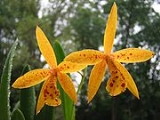
Potinara
Encyclopedia
Potinara, abbreviated Pot in the horticultural trade, is the nothogenus comprising those intergeneric hybrids of orchids which have Brassavola
, Cattleya
, Laelia
and Sophronitis
as parent genera.
It can easily be imagined that a combination of all the desirable qualities of the four genera would be an outstandingly handsome thing. However, plants in which all the desired qualities show up occur in only a small proporation of the offspring, and the percentage of plants homozygous for all qualities even less often. A rather extensive breeding program would be necessary to achieve the ideal results. Many lovely combinations do occur in Potinara crosses, although relatively few have been made.
The search for a way to breed large red hybrids has been given a new boost with the discovery of Cattleya milleri. It is hoped that this species will not offer the genetic difficulties that have plagued hybridists using Sophronitis. Some encouraging results have already been achieved. (C. milleri is one of the grandparents of the pictured Brassocattleya Hoku Gem.)
was merged into Cattleya, making such nothogenera as Potinara, Sophrolaeliocattleya
and Sophrocattleya
no longer current, but only of historical interest. At the same time, several species of Cattleya which had been widely used in hybridization were moved into the new genus Guarianthe
. (Two species of Brassavola, B. digbyana and B. glauca had been moved into the new genus Rhyncholaelia
earlier in the decade.) As a result, greges which were once classified in Potinara are now found in several genera and nothogenera.
Brassavola
Brassavola is a genus of 20 orchids . They were named in 1813 by the Scottish botanist Robert Brown. The name comes from the Venetian nobleman and physician Antonio Musa Brassavola. This genus is abbreviated B. in trade journals....
, Cattleya
Cattleya
Cattleya is a genus of 113 species of orchids from Costa Rica to tropical South America. The genus was named in 1824 by John Lindley after Sir William Cattley who received and successfully cultivated specimens of Cattleya labiata that were used as packing material in a shipment of other orchids...
, Laelia
Laelia
Laelia, abbreviated L. in the horticultural trade, is a small genus of 25 species from the orchid family . This is one of the most important and popular orchid genera, because of the beautiful flowers, their genetic properties and because they are fairly easy in culture. It is probably named after...
and Sophronitis
Sophronitis
Sophronitis, abbreviated Soph in horticultural trade, is a genus of small, epiphytic or lithophytic orchids, growing in the damp montane forest of eastern Brazil, Paraguay and NE Argentina. Currently, 65 species are recognized....
as parent genera.
It can easily be imagined that a combination of all the desirable qualities of the four genera would be an outstandingly handsome thing. However, plants in which all the desired qualities show up occur in only a small proporation of the offspring, and the percentage of plants homozygous for all qualities even less often. A rather extensive breeding program would be necessary to achieve the ideal results. Many lovely combinations do occur in Potinara crosses, although relatively few have been made.
The search for a way to breed large red hybrids has been given a new boost with the discovery of Cattleya milleri. It is hoped that this species will not offer the genetic difficulties that have plagued hybridists using Sophronitis. Some encouraging results have already been achieved. (C. milleri is one of the grandparents of the pictured Brassocattleya Hoku Gem.)
History
In 2008, the genus SophronitisSophronitis
Sophronitis, abbreviated Soph in horticultural trade, is a genus of small, epiphytic or lithophytic orchids, growing in the damp montane forest of eastern Brazil, Paraguay and NE Argentina. Currently, 65 species are recognized....
was merged into Cattleya, making such nothogenera as Potinara, Sophrolaeliocattleya
Sophrolaeliocattleya
Sophrolaeliocattleya is a nothogenus of artificial intergeneric orchid hybrids...
and Sophrocattleya
Sophrocattleya
Sophrocattleya is an intergeneric hybrid of orchids. The genus is abbreviated Sc. in the horticultural trade....
no longer current, but only of historical interest. At the same time, several species of Cattleya which had been widely used in hybridization were moved into the new genus Guarianthe
Guarianthe
Guarianthe, abbreviated Gur. in the horticultural trade, is a small genus of epiphytic orchids, growing in wet forests in Central America and northern South America. It was separated from the bifoliate Cattleyas in 2003, based on phylogenetic studies of nuclear DNA sequence data- Species...
. (Two species of Brassavola, B. digbyana and B. glauca had been moved into the new genus Rhyncholaelia
Rhyncholaelia
Rhyncholaelia, abbreviated Rl. in the horticultural trade, is a genus of orchids , comprising 2 species. They are distributed in Mexico, Guatemala, Belize, and Honduras. Both species were originally published in Brassavola by Lindley. In 1918, Schlechter erected the new genus Rhyncholaelia and...
earlier in the decade.) As a result, greges which were once classified in Potinara are now found in several genera and nothogenera.

